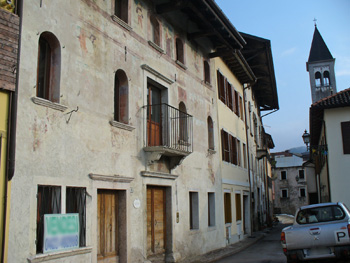| Card n. | Description | Locality | Linked sites |
| 57 | Borgo Piave | Belluno | 3 - 11 - 10 |
| file .pdf | Architecture Art History (ASA) - Ethnographic Sites (SE) | Google maps | 9 - 129 |
 |
 |
- Description
- How to get there
- Interesting facts
- Bibliography
Today a residential area, this was once an important port area of Belluno, linked above all to the timber trade and to the manufacturing activities that exploited the hydraulic energy generated by the nearby Ardo torrent. Borgo Piave, spread out on the slopes of the hill of the Old Town of Belluno sits on the bed of the Piave and links the town, both morphologically and symbolically, with the river, although the present-day embankment and the condition of some of the buildings prevent us from fully appreciating just how strong this link is and how far back it goes. The housing developed up around the Church of San Nicolò, the patron saint of the raftsmen, and the water-powered industrial establishments in the eastern part of the neighbourhood; the restructured building opposite the church was used for tanning leather, while to the east was a cereal mill; there was also a sawmill at the far end of the neighbourhood. Since it was a port, Borgo Piave played a central role in the busy trade in all sorts of goods, including fish, resin, woollen cloth, cattle, iron, copper, coal, stones, etc. On the road linked to the port, inhabited by important citizens and craftsmen, duty was paid on the goods that were transported along the Piave and had to be kept here overnight. Most of the houses, built close to one another, date back to the 15th and 16th centuries, such as Casa Secco (11 HAA), with its frescoed façade; Casa Fantuzzi (10 HAA), featuring a portico with a paved interior and an internal courtyard, once home to Giuseppe Fantuzzi, a general of Napoleon’s army and the son of a raftsman, and Casa Doglioni (9 HAA), also known as Botegon, which was once a tavern frequented by the raftsmen and tanners who founded the first workers’ associations and mutual aid societies here. There was once a bridge here across to the left side of the Piave, which was subject to collapse at regular intervals. In 1410 it was established that the port of the Piave was to stretch from the strip of land in the north, between the Piave and the Ardo, to Lambioi.
From the centre of Belluno, go down towards the Piave; the neighbourhood lies between Via Uniera dei Zater and the flow of the River Piave, near the Vittoria Bridge.
From the left bank of the Piave, you can reach the south of Belluno from the Dolomiti Bridge and Via Sarajevo. Past the Ardo torrent, walk along the right bank (Via Lungardo) and through the colonnade of the Colle tannery into the neighbourhood.
ACCESSIBLE: outside only
MUNICIPALITY: Belluno
PLACE: Borgo Piave
GEOGRAPHICAL COORDINATES: X 1748986 – Y 5114059
PROVINCE: Belluno
FILE COMPILED BY: Bonato/Eulisse
The tannery business in Borgo Piave was established in 1700, when the Colle family left Cesana di Lentiai to settle in Belluno, where they created a flourishing business. The large Colle tannery (129 CA), built on the right bank of the Piave, closed down for good in 1957. The recovery of the former tanneries is part of an urban redevelopment project for an area that was abandoned for many years. The multi-function building, mostly composed of flats, was designed in 2001 by Giovanni Pante and constructed between 2003 and 2008, attempting to create links with the characteristic morphological elements of the setting, such as its being built up towards the hill and the persistence of the riverbank. Another aim of the project was to reinterpret a number of formal aspects typical of the neighbourhood, such as the gable roofs, the overhangs, the garrets and the arches of the nearby portico.
A. Bondesan, F. Vallerani, M. Zanetti, Il Piave, Belluno, 2000
M. Cassol, L. Facchin, Il torrente Ardo. Itinerario lungo il corso d’acqua dalla città di Belluno al Parco Nazionale delle Dolomiti Bellunesi, Belluno, 1993
G. De Bortoli, A. Moro, F. Vizzutti, Belluno. Storia architettura arte, Belluno, 1984
A. Fontana, F. Vizzutti, Borgo Piave 1, Belluno, 1980

